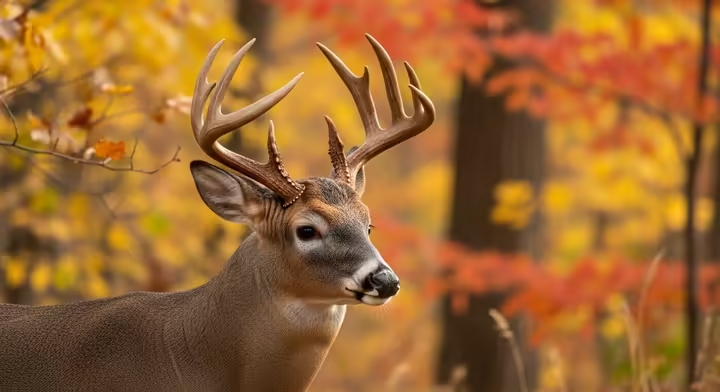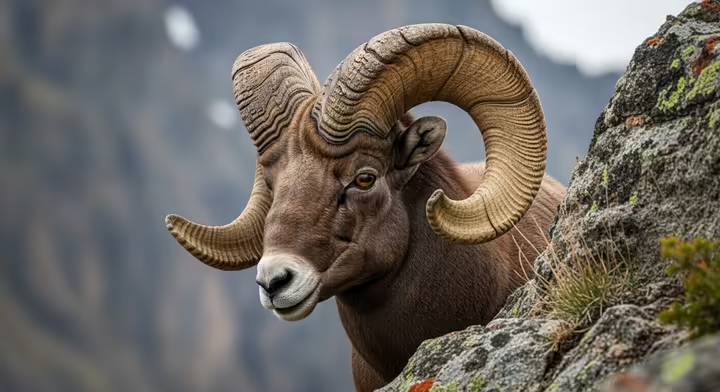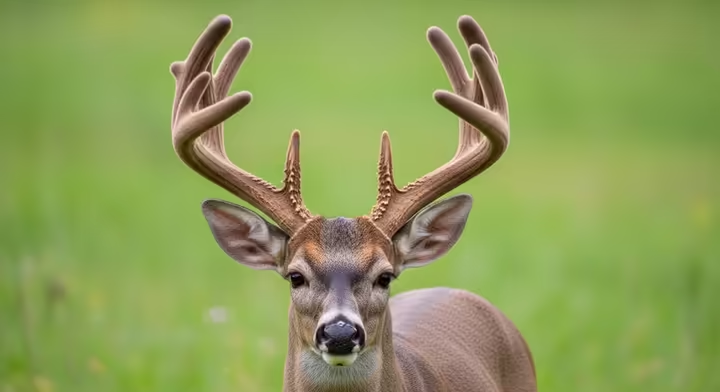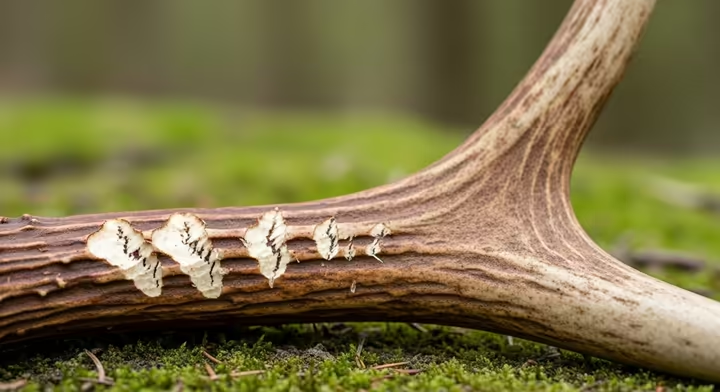Why Deer Shed Their Antlers
Ever wonder why a buck's magnificent antlers just... fall off his head? It seems like a waste of a perfectly good crown, right? This isn't just a weird quirk, it's a super-smart biological trick tied to sunlight, hormones, and survival. Let's get into why deer grow and ditch their headgear every single year.
Antlers vs. Horns: What's the Diff?
First things first, we need to clear something up. People use "antlers" and "horns" like they're the same thing, but biologically, they're worlds apart. Getting this right is key to understanding the whole shed cycle.
The Deal with Antlers
Antlers belong to the deer family (Cervidae). This includes whitetails, mule deer, elk, moose, and caribou. They are made of solid bone and grow from two permanent bumps on the skull called pedicles.
They're one of the fastest-growing tissues in the animal kingdom... seriously. But the wildest thing about antlers? They fall off. Every single year, a deer grows a whole new set, with only the males growing them (with one weird exception we'll get to later).

The Deal with Horns
Horns are different. You'll find them on animals in the Bovidae family, like bighorn sheep, mountain goats, and cattle. A horn is a two-part deal: a bony core on the inside with a sheath of keratin (the same stuff as your fingernails) on the outside.

Horns are for life. They never fall off, and they keep growing throughout the animal's life. If you break a horn, it's broken for good. Both males and females can have horns, and they're always a single, unbranched spike (though they can be curvy).
So what’s the point of these differences? Horns are permanent, all-season tools for defense. Antlers are seasonal weapons, grown just for the fall mating season (the rut). Growing them takes a ton of energy, so dropping them for the winter is a smart way to save fuel when food is scarce.
| Characteristic | Antlers | Horns |
|---|---|---|
| Composition | True, solid bone | Bony core with a keratin sheath |
| Growth Cycle | Shed and regrown annually | Permanent; grow continuously |
| Animal Family | Cervidae (Deer, Elk, Moose) | Bovidae (Sheep, Goats, Bison) |
| Structure | Typically branched | Always unbranched |
| Sex Distribution | Males only (exception: Caribou) | Often present in both sexes |
The Antler Clock: How It Works
Dropping and regrowing antlers isn't random. It's a precise process run by a biological clock that uses sunlight to get everything timed perfectly for the breeding season.
Sunlight and Hormones
It all starts with sunlight. The amount of daylight in a 24-hour period, called the photoperiod , is the master switch for the whole cycle. It's way more reliable than temperature, so it’s the perfect natural timer.
In spring, more daylight triggers a slight bump in the male hormone testosterone , which kicks off new antler growth. As the antlers grow through summer, they’re soft and covered in a fuzzy, blood-rich skin called velvet . This velvet is like a 24/7 nutrient pipeline, feeding what is the fastest-growing bone in the world, an inch a day for a big bull elk!
As fall approaches, less daylight tells the buck's brain to crank up testosterone production. This hardens the antler bone and cuts off blood flow to the velvet, which dries up and gets rubbed off. Now the antlers are hard, polished bone, ready for business.

But after the party's over (the rut), testosterone levels crash. This sudden drop is the signal: time to ditch the antlers.
The Demolition Crew
Dropping an antler isn't an accident. It’s a planned demolition job at the cellular level. Lower testosterone wakes up special cells called osteoclasts at the base of the antler.
The job of these osteoclasts is to eat away at the bone where the antler meets the skull, creating a weak spot called the abscission line . Once the connection is weak enough, the antler's own weight, or a little bump on a tree, is enough to make it pop right off.
After the antler falls off, the spot on the head (the pedicle) is a bit bloody. But it heals super fast, scabs over, and gets ready to grow a new antler almost right away.
So why don't does grow antlers? It's all about testosterone. Does don't have enough of it to even start the process... in fact, the female hormone estrogen actually blocks it. (Though very rarely, a doe with a hormone problem might grow a weird, small, velvet-covered rack).
When Do They Drop?
Okay, so we know *why* they drop. But *when*? The sun sets the basic calendar, but a buck's health, age, and stress levels decide the exact date. For a shed hunter, knowing this turns a random event into useful intel.
General Timelines
In North America, moose go first, usually dropping their huge antlers from November to January. Whitetails and mule deer follow, mostly from late December to March. Elk are the late-comers, shedding mostly in March and April.
Where you live matters too. In the chilly Midwest and Northeast, most bucks have shed by late March. Down in the Southeast, the schedule is looser, with some deer holding on to their antlers until April.
What Affects the Timing?
The date a buck sheds is a direct report on his physical condition after a long winter. An early drop is often a red flag.
- Health and Nutrition: This is the biggest factor. A healthy, well-fed buck holds his antlers longer. An early drop can signal stress, bad food, or injury.
- Age and Dominance: Surprisingly, the big, dominant bucks often drop theirs first. They burn so much energy during the rut that they're wiped out by winter and need to conserve energy sooner.
- Injury and Disease: A bad injury (like from a car) can cause a buck to shed super early as his body redirects energy to healing. On the flip side, an injury to the testes can mess up testosterone production, causing a buck to keep his velvet-covered antlers indefinitely. This creates a gnarly, tumor-like growth known as a "cactus buck."
- Environmental Stress: A tough winter with lots of snow and cold means an earlier shed for everyone. It’s all about saving energy to survive.
- Genetics: Just like people, deer have their own internal clocks. A healthy buck will often shed his antlers within the same few days each year.
Captive deer, with their five-star meals and no worries, often grow bigger antlers and have more predictable shed schedules. This really shows how much nutrition matters in the wild.
A Wrinkle in Time: Climate Change
**Phenology** is the study of nature's timing, things like migration or when plants flower, and climate change is messing with it. While daylight hours stay the same, warmer springs mean plants green-up earlier.
This can create a "mismatch." The deer's clock is set by the sun, but their main food source might be arriving on a different schedule. The long-term effects of this are a hot topic for wildlife researchers.
Why It All Matters
The annual shed cycle is way more than just a weird biological fact. It's a key part of a deer's life, a gift to the forest, and a source of valuable clues for hunters and wildlife watchers.
A Brutally Honest Resume
Growing antlers is crazy expensive, biologically speaking. A buck has to pull minerals like calcium from his own ribs to do it, a process called reversible osteoporosis. It sounds painful, but it's part of the plan.
Because they're so hard to grow, antlers are an "honest signal" of a buck's fitness. You can't fake a big rack, it means you're healthy, well-fed, and have good genes. This makes antlers a reliable advertisement for both lady deer and rival bucks.
And because he grows a new set every year, it's an up-to-date report card. It's not about how strong he was five years ago, it's about how strong he is *right now*. This helps rivals size each other up without having to fight to the death.
A Gift to the Forest
An antler's job isn't done when it hits the ground. It's a mineral-packed snack for the rest of the forest. A shed antler is a block of calcium, phosphorus, and other goodies.
In forests with poor soil, these minerals are hot commodities. Rodents like squirrels, mice, and porcupines are the main customers, gnawing on the bone to get minerals they need. This is nature's recycling program, returning nutrients the buck collected back into the food web.

What Sheds Tell You
This is where "shed hunting" comes in. Looking for fallen antlers is more than a hobby, it's detective work. Finding a shed confirms a buck made it through winter and the hunting season.
The location shows you where he was hiding out during the toughest months, revealing core bedding areas and food sources. A collection of sheds from one area can help you track a buck's growth over the years.
Conclusion
So, there you have it. Antlers aren't just fancy headgear. They're a biological marvel, a resume, and a vital part of the forest ecosystem. The whole cycle, from fuzzy velvet to the final 'clunk' as they hit the ground, is a perfectly tuned system run by sunlight and survival.
Next time you see a buck, or find a shed antler on the ground, you'll know the whole amazing story behind it. It’s a reminder that even in the quietest parts of the year, the woods are full of incredible natural processes.
Glossary
- Abscission Line: The specific zone of separation at the base of an antler where specialized cells weaken the bone, allowing it to be shed from the pedicle.
- Antler: A paired, branched, true bone structure grown and shed annually by members of the deer family.
- Bovidae: The scientific family of mammals that includes cloven-hoofed ruminants with unbranched, permanent horns, such as cattle, goats, sheep, and antelope.
- Cast Antler: An antler that has been naturally shed by a deer, elk, or moose. Also known as a "shed."
- Cervidae: The scientific family of mammals commonly known as the deer family, characterized by the annual growth and shedding of antlers in males (and in female caribou).
- Horn: A permanent, two-part structure consisting of a bony core covered in a keratin sheath, found on members of the family Bovidae . Horns are never shed.
- Osteoclast: A specialized type of bone cell that breaks down bone tissue. Osteoclasts are responsible for creating the abscission line that allows antlers to be shed.
- Pedicle: The permanent bony protuberance on the frontal bone of a deer's skull from which an antler grows.
- Photoperiod: The duration of an organism's daily exposure to light, which acts as the primary environmental cue for seasonal biological cycles like antler growth and shedding.
- Rut: The annual breeding season for deer and other similar animals, characterized by heightened activity and aggression in males, driven by peak testosterone levels.
- Velvet: The soft, hair-like, vascularized skin that covers and nourishes a growing antler, supplying it with the blood, oxygen, and nutrients necessary for rapid bone growth.
Further Reading & Resources
University Extension and Research Centers:
- Mississippi State University Deer Ecology and Management Lab: A leading research institution providing in-depth articles on deer biology, including antler growth and physiology.
- University of Missouri Extension: Offers practical publications on deer management, including methods for monitoring herd health using observational and harvest data.
- Michigan State University Extension: Provides accessible articles on wildlife topics, including the biology of antler shedding and the practice of shed hunting.
Conservation Organizations:
- National Deer Association (NDA): A primary resource for deer hunters and managers, publishing articles and research on all aspects of deer biology, habitat, and conservation.
State Wildlife Agencies:
- State Department of Natural Resources (DNR) or Game and Fish websites (e.g., Wyoming Game & Fish Department, Oregon Department of Fish and Wildlife) are excellent sources for region-specific information, research, and regulations related to deer and shed hunting.
Key Scientific Literature:
- Moyes, K., et al. (2011). "Getting the timing right: Antler growth phenology and sexual selection in a wild red deer population." Global Change Biology . This study provides key evidence of climate change affecting the timing of the antler cycle in red deer.
- Price, J., et al. (2005). "Deer Antlers: A Model of Mammalian Appendage Regeneration." Current Topics in Developmental Biology . A comprehensive review of the cellular and molecular mechanisms of antler regeneration.
- Vanpé, C., et al. (2007). "Antler Size Provides an Honest Signal of Male Phenotypic Quality in Roe Deer." The American Naturalist . A foundational study demonstrating the evolutionary principle of antlers as an honest signal of fitness.
Works cited
- Antlers vs. Horns | Nebraskaland Magazine, https://magazine.outdoornebraska.gov/blogs/nebraska-nature/antlers-vs-horns/
- Differences Between Antlers and Horns - Jeevoka, https://jeevoka.com/differences-between-antlers-and-horns/s
- Fun Facts: Antlers or Horns? — Edmonton & Area Land Trust, https://www.ealt.ca/blog/fun-facts-antlers-or-horns
- 21+ Animals With Horns (and Antlers) + Pictures and Facts - Outforia, https://outforia.com/animals-with-horns/
- Horns versus Antlers (U.S. National Park Service), https://www.nps.gov/articles/yell-horns-vs-antlers.htm
- www.nps.gov, https://www.nps.gov/articles/yell-horns-vs-antlers.htm#:~:text=Antlers%E2%80%94found%20on%20members%20of,are%20a%20two%2Dpart%20structure.
- Horns and Antlers - ADW, https://animaldiversity.org/collections/mammal_anatomy/horns_and_antlers/
- Mark, what is the difference between horns and antlers? | Wyoming Game & Fish Department, https://wgfd.wyo.gov/Ask-Game-and-Fish/Mark%2C-what-is-the-difference-between-horns-and-ant
- Antlers vs. Horns: Key Differences in Nature's Headgear | Wonders of Wildlife, https://wondersofwildlife.org/2024/antlers-vs-horns-key-differences-in-natures-headgear/
- magazine.outdoornebraska.gov, https://magazine.outdoornebraska.gov/blogs/nebraska-nature/antlers-vs-horns/#:~:text=True%20antlers%20are%20made%20of,the%20horns%20are%20shed%20yearly.
- A Pointed Article About Antlers and Horns - Friends of Silver Falls, https://www.friendsofsilverfalls.net/stories/2020/10/10/a-pointed-article-about-antlers-and-horns
- What's the difference between horns and antlers? - Discover Wildlife, https://www.discoverwildlife.com/animal-facts/mammals/whats-the-difference-between-horns-and-antlers
- Antlers vs. Horns: What's the Difference? - Treehugger, https://www.treehugger.com/antlers-or-horns-whats-the-difference-4864559
- Horns VS Antlers: Which Are Best? - Fox Run Environmental Education Center, https://www.foxrunenvironmentaleducationcenter.org/new-blog/2024/8/27/horns-vs-antlers-which-are-best
- Those Things On Their Heads - Antlers Vs. Horns - Yukon Wildlife Preserve, https://yukonwildlife.ca/those-things-on-their-heads-antlers-vs-horns-2023-01/
- Antler - Wikipedia, https://en.wikipedia.org/wiki/Antler
- Something Wild: The Many Benefits of Antlers - Forest Society, https://www.forestsociety.org/something-wild/something-wild-many-benefits-antlers
- Why bucks shed their antlers | Mississippi State University Extension Service, http://extension.msstate.edu/news/extension-outdoors/2016/why-bucks-shed-their-antlers
- Hunting antler sheds: A fun and informative winter pastime - White-Tailed Deer Management, https://www.canr.msu.edu/news/searching-for-antler-sheds-can-be-a-fun-end-of-winter-pastime
- MULE DEER ANTLER DEVELOPMENT Fact Sheet #27, https://wgfd.wyo.gov/media/31634/download?inline
- THE SCIENCE OF - Whitetail Institute, https://whitetailinstitute.com/content/Whitetail%20News/management/The%20Science%20of%20Antler%20Growth%20by%20Matt%20Harper.pdf
- Whitetail Deer Antler Growth Process - Texas Hunter Products, https://www.texashunterproducts.com/blog/whitetail-deer-antler-growth-process/
- Eight points about antlers | U.S. Fish & Wildlife Service, https://www.fws.gov/story/eight-points-about-antlers
- Behind the Hide: A Deep Dive Into Deer Hormones, https://www.deeranddeerhunting.com/content/articles/deer-hormones-behind-the-hide
- Whitetail Dispositions The Driving Force of the Rut - Minnesota Deer Hunters Association, https://mndeerhunters.com/about-mdha/news/88-from-whitetales/146-whitetail-dispositions-the-driving-force-of-the-rut
- TRT vs. the Rut: Reclaiming Your Primal Edge - Quali-T Men's Health, https://quali-tmenshealth.com/do-men-go-through-rut
- Antler Growth Cycle | Deer Ecology & Management Lab | Mississippi State University, https://www.msudeer.msstate.edu/growth-cycle.php
- When and Why Deer Antlers Fall Off | Mossy Oak, https://www.mossyoak.com/our-obsession/blogs/deer/when-and-why-deer-antlers-fall-off
- Abscission scars with Howship's lacunae in early antlers. a, b Shed... - ResearchGate, https://www.researchgate.net/figure/Abscission-scars-with-Howships-lacunae-in-early-antlers-a-b-Shed-dichotomous-antler-of_fig4_347336204
- Does It Hurt When Deer Shed Their Antlers or Velvet?, https://outdoorempire.com/does-it-hurt-when-deer-shed-their-antlers/
- Shed Hunting - Weston, MA, https://www.westonma.gov/CivicSend/ViewMessage/message/103118
- Deer Antler Pedicles Are Unique, Like Fingerprints, https://www.deeranddeerhunting.com/deer-scouting/deer-behavior/deer-antler-pedicles-are-unique-like-fingerprints
- Deer Antler Regeneration | Woods N Water News, https://woods-n-waternews.com/2013/05/01/articles-in-this-issue-i-2013-05-01-215585-112113-deer-antler-regeneration-html/
- Deer antler renewal gives insights into mammalian epimorphic regeneration - PMC, https://pmc.ncbi.nlm.nih.gov/articles/PMC10368610/
- The Hormone-Dependent Regenerative Basis of Antlers ..., https://bioengineering.hyperbook.mcgill.ca/the-hormone-dependent-regenerative-basis-of-antlers/
- Antler Growth: Nutritional and Endocrine Factors - Deer Industry NZ, https://www.deernz.org/assets/Deer-Hub/Velvet-and-antlers/antler-growth-nutritional-and-endochrine.pdf
- Deer antlers: a zoological curiosity or the key to understanding organ regeneration in mammals? - PMC, https://pmc.ncbi.nlm.nih.gov/articles/PMC1571559/
- Why Do Female Deer Sometimes Grow Antlers? | MeatEater Conservation News, https://www.themeateater.com/conservation/wildlife-management/why-do-female-deer-sometimes-grow-antlers
- Antler Development in White-tailed Deer: Implications for Management | MU Extension - University of Missouri, https://extension.missouri.edu/publications/g9486
- When and why do bulls and bucks shed their antlers? | RMEF Media ..., https://www.rmef.org/elk-network/bulls-bucks-shed-antlers/
- When and How Elk, Deer & Moose Shed Their Antlers, https://ridgerunnerantlerchews.com/blogs/the-dog-dirt/when-and-how-elk-deer-and-moose-shed-their-antlers
- When Is the Right Time to Go Shed Hunting? - North American ..., https://www.northamericanwhitetail.com/editorial/right-time-to-go-shed-hunting/516159
- Discover the Best Times and Places for Shed Hunting Across America | Whitetail Properties, https://www.whitetailproperties.com/knowledge-center/discover-the-best-times-and-places-for-shed-hunting-across-america
- Why Deer Shed Their Antlers | Whitetail Properties, https://www.whitetailproperties.com/knowledge-center/why-deer-shed-their-antlers
- Deer Antlers - The journey from growth to shedding | N1 Outdoors, https://n1outdoors.com/deer-antlers/
- How to Read Shed Antlers for Deer Health and Habitat Clues - YouTube, https://www.youtube.com/watch?v=q0oCch51ELs
- Why Bucks Are Dropping Antlers EARLY (And What It Means for Your Herd!) - YouTube, https://www.youtube.com/watch?v=J7_riEqLL4Q
- The Causes of Antler Asymmetry, https://www.deeranddeerhunting.com/content/articles/the-causes-of-antler-asymmetry
- Teal, what causes antler deformities? | Wyoming Game & Fish Department, https://wgfd.wyo.gov/Ask-Game-and-Fish/Teal%2C-what-causes-antler-deformities
- Deer Antler Abnormalities | Panhandle Agriculture - nwdistrict.ifas.ufl.edu |, https://nwdistrict.ifas.ufl.edu/phag/2013/02/15/deer-antler-abnormalities/
- Testicular lesions and antler abnormalities in Colorado, USA mule deer (Odocoileus hemionus): a possible role for epizootic hemorrhagic disease virus - PubMed, https://pubmed.ncbi.nlm.nih.gov/25375947/
- The Injuries and Illnesses that Trigger Amazing Antlers | MeatEater Wired To Hunt, https://www.themeateater.com/wired-to-hunt/whitetail-management/the-injuries-and-illnesses-that-trigger-amazing-antlers
- The Truth About Cold Weather and Shed Antlers - Deer & Deer Hunting, https://www.deeranddeerhunting.com/content/blogs/dan-schmidt-deer-blog-whitetail-wisdom/the-truth-about-cold-weather-and-shed-antlers
- White-tailed Deer: Are Antler Characteristics Inherited?, https://tpwd.texas.gov/huntwild/wild/game_management/deer/antlers_inherited/
- The Role of Genetics and Nutrition in Deer Management | Mississippi State University Extension Service, http://extension.msstate.edu/publications/the-role-genetics-and-nutrition-deer-management
- Protocol for Assessing the Relative Effects of Environment and Genetics on Antler and Body Growth for a Long-lived Cervid, https://pmc.ncbi.nlm.nih.gov/articles/PMC5614118/
- Mismatch Between Birth Date and Vegetation Phenology Slows the Demography of Roe Deer | PLOS Biology - Research journals, https://journals.plos.org/plosbiology/article?id=10.1371/journal.pbio.1001828
- Climate Change | Isle of Rum Red Deer Project, https://rumdeer.bio.ed.ac.uk/climate-change
- The Early Deer—and the Late Ones—Get the Herbs | U.S. Geological Survey - USGS.gov, https://www.usgs.gov/news/science-snippet/early-deer-and-late-ones-get-herbs
- Mismatch Between Birth Date and Vegetation Phenology Slows the Demography of Roe Deer - PMC, https://pmc.ncbi.nlm.nih.gov/articles/PMC3972086/
- Minerals for Whitetails | National Deer Association, https://deerassociation.com/minerals-for-whitetails/
- Discover Antlers: How big? Why they fall off? - Naturally North Idaho, https://www.naturallynorthidaho.com/2024/03/discover-antlers-how-big-why-they-fall-off.htm
- Antler Size Provides an Honest Signal of Male Phenotypic Quality in ..., https://www.researchgate.net/publication/312104851_Antler_Size_Provides_an_Honest_Signal_of_Male_Phenotypic_Quality_in_Roe_Deer
- Why Are Male Antlers And Horns So Large? - ScienceDaily, https://www.sciencedaily.com/releases/2007/03/070319114501.htm
- Antler size provides an honest signal of male phenotypic quality in roe deer - PubMed, https://pubmed.ncbi.nlm.nih.gov/17273980/
- Antlers honestly advertise sperm production and quality - PMC, https://pmc.ncbi.nlm.nih.gov/articles/PMC1634960/
- Fun Facts about Reindeer and Caribou - FDA, https://www.fda.gov/animal-veterinary/animal-health-literacy/fun-facts-about-reindeer-and-caribou
- Caribou | Denali Education Center, https://www.denali.org/natural-history/caribou/
- Caribou Migration - Journey North, https://journeynorth.org/tm/caribou/AntlersA.html
- Huh? Do Female Reindeer Have Antlers? - Parade, https://parade.com/living/do-female-reindeer-have-antlers
- Caribou Migration - Journey North, https://journeynorth.org/tm/caribou/AntlersB.html
- In most deer species, only the males grow antlers. For reindeer, both the males and females grow them. A female reindeer begins growing antlers in May and keeps them all the way until after the Winter birthing season to protect their young from predators (perfect Mother's Day fact) :) : r/Awwducational - Reddit, https://www.reddit.com/r/Awwducational/comments/ulg8qm/in_most_deer_species_only_the_males_grow_antlers/
- What kind of minerals do they need? - Antler King, https://antlerking.com/what-kind-of-minerals-do-they-need/
- Sustainability Practices of Antlers - Antler Chew, https://antlerchew.co.uk/blogs/news/sustainability-of-antlers
- The Best Shed Hunting Tips For Finding Better Success - North American Whitetail, https://www.northamericanwhitetail.com/editorial/20-shed-hunting-tips-for-better-success/470506
- Shed Antler Hunting for Beginners 101 | Mossy Oak, https://www.mossyoak.com/our-obsession/blogs/how-to/shed-hunting-101
- Hidden Gems: The Rewards and Strategies of Shed Hunting ..., https://www.scentlok.com/hidden-gems-the-rewards-and-strategies-of-shed-hunting/
- How to Read Shed Antlers for Health and Habitat Clues | National Deer Association, https://deerassociation.com/how-to-read-shed-antlers-for-health-and-habitat-clues/
- Antler Restriction Regulation - Texas Parks & Wildlife Department, https://tpwd.texas.gov/huntwild/wild/game_management/deer/antler_restrictions/
- Estimating Deer Populations on Your Property: Observational Data | MU Extension, https://extension.missouri.edu/publications/g9482
- Estimating Deer Populations on Your Property: Harvest Data | MU Extension, https://extension.missouri.edu/publications/g9483
- Can You Estimate a Buck's Age From His Shed Antler? | National Deer Association, https://deerassociation.com/can-estimate-bucks-age-shed-antler/
- deerassociation.com, https://deerassociation.com/can-estimate-bucks-age-shed-antler/#:~:text=%E2%80%9CSo%2C%20I%20do%20not%20think,3%C2%BD%20years%20old%20and%20older.%E2%80%9D
- Deer Aging | Oklahoma Department of Wildlife Conservation, https://www.wildlifedepartment.com/hunting/resources/deer/age
- Biology of the Rut | Deer Ecology & Management Lab | Mississippi State University, https://www.msudeer.msstate.edu/biology-of-the-rut.php